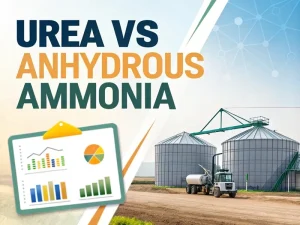
Urea VS Anhydrous Ammonia
Tech Blog urea vs anhydrous ammonia Nitrogen is the “lifeline” of crop growth, directly affecting leaf development, photosynthetic efficiency, and yield potential. For global farmers,


Urea, also known as carbamide. It is a white crystal containing carbon, nitrogen, oxygen, and hydrogen. One of the simplest organic compounds, it is the main nitrogenous end product of the metabolic breakdown of proteins in mammals and some fish.
Urea, being a neutral fertilizer, is well-suited for a wide range of soils and plants. It is easy to store and use and has a small, destructive effect on the soil. It is a chemical nitrogen fertilizer used in large quantities and is also the nitrogen fertilizer with the highest nitrogen content. Under specific conditions, the industry utilizes ammonia and carbon dioxide to produce urea through synthesis.
Urea Chemical Formula: NH2CONH2/ CH4N2O
Urea Cas No: 57-13-6
Urea Molecular Wt: 60.056 g/mol
Urea Melting Point: 132.7 ℃
Urea Boiling Point: 196.6°C/Standard atmospheric pressure
Urea Density: 1.335 g/cm³
Solubility Of Urea In Water: 1080 g/L (20℃)
Urea Flash Point: 72.7 ℃

Urea is readily soluble in water, dissolving 105 grams in 100 millilitres of water at 20 degrees Celsius, with a neutral reaction in an aqueous solution.
There are two kinds of urea products. Crystalline urea is a white acicular or prismatic crystal, hygroscopic, hygroscopic agglomeration, and hygroscopicity 12 times faster than granular urea. In granular urea for particle size 1 ~ 2 mm translucent particles, the appearance of smooth hygroscopicity has improved significantly. 20 ℃ when the critical hygroscopicity point for the relative humidity is 80%, but 30 ℃, the critical hygroscopicity point is down to 72.5%, so the urea should be avoided in the summer humid climate open storage.
In the production of urea, the hygroscopicity of the urea is significantly reduced by adding hydrophobic substances such as paraffin.
Urea can interact with acids to form salts. It can undergo condensation reactions at high temperatures to produce diurea, triurea and cyanuric acid. Heated to 160 ℃ decomposition, the production of ammonia gas simultaneously into isocyanic acid. It is named urea because it is contained in human urine. Urea contains nitrogen (N) 46%, the highest nitrogen content in solid nitrogen fertilizers.
Urea in the acid, alkali, and enzyme action (the acid and alkali need to be heated) can be hydrolyzed to generate ammonia and carbon dioxide.
It is unstable to heat and will be deaminated into diurea when heated to 150~160℃. The reaction between copper sulphate and diurea is purple, which can be used to identify urea.
Acetyl urea and diacetyl urea can be generated by interaction with acetyl chloride or acetic anhydride.
It reacts with diethyl malonate under the action of sodium ethanol to form malonylurea (also called barbituric acid because of its particular acidity).
In the presence of alkaline catalysts like ammonia, it has the ability to react with formaldehyde and undergo condensation to form urea-formaldehyde resin.It reacts with hydrazine hydrate to form aminourea.
Urea was discovered by Hilaire Rouelle in 1773 and was first synthesized artificially in 1828 by the German chemist Friedrich Wille using the inorganic substance ammonium cyanate (NH4CNO, an inorganic compound that can be produced by the reaction of ammonium chloride and silver cyanate) with ammonium sulphate. Initially, he intended to synthesize ammonium cyanate, but instead, he obtained urea.
The synthesis of urea inaugurated the artificial synthesis of organic matter. This proved the vitalism theory wrong and opened up organic chemistry (The vitalism theory holds that inorganic matter is fundamentally different from organic matter, so that inorganic matter cannot be turned into organic matter and that organic compounds can only be produced by the cells of living things under the action of a special force, the vital force, and that artificial synthesis is not possible. Mammals, amphibians, and some fish contain urea in their urine; birds and reptiles emit uric acid because their nitrogen metabolism processes use less water).
Urea represents the ultimate product of protein metabolism in mammals. In 1922, Germany industrialized the production of urea synthesized from ammonia and carbon dioxide. Ammonia reacts with carbon dioxide to form amine carbamate, which is dehydrated to form urea.
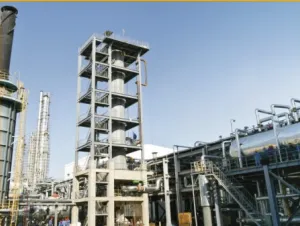
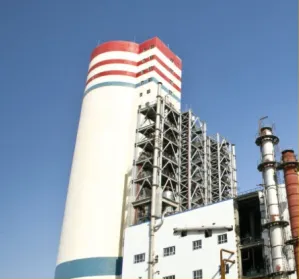
Specific agents containing urea in dermatology enhance the skin’s moisture content. Closure dressings used for non-surgically removed nails contain 40% urea.
The carbon-14-breath test, which detects H. pylori, uses urea containing carbon 14 or carbon 13 markers. H. pylori’s urease enzyme uses urea to make ammonia and raise the stomach’s pH. The same principle can be used to test similar bacteria living in animal stomachs
Urea is a highly concentrated nitrogen fertilizer. It is a neutral, quick-acting fertilizer that can also be used to produce a variety of compound fertilizers. It does not leave any harmful substances in the soil and has no adverse effects when applied for a long time.
It can be used as feed for ruminants in animal husbandry. However, too high a temperature in granulation will produce a small amount of urea, also known as biuret, which has an inhibitory effect on crops.
Urea can promote cell division and growth so that the branches and leaves grow luxuriantly. Here are some of its specific applications:
Please read this article for specific applications of urea in agriculture CLICK THIS
Urea is very effective at denaturing proteins and is particularly effective at destroying non-covalently bonded proteins. This characteristic can increase the solubility of specific proteins at concentrations of up to 10 moles/volume. Urea can also be used to make urea nitrate.
As China leading urea supplier, we have industrial urea (prilled urea&granular urea), automotive grade urea(Adblue/DEF Urea).

Tech Blog urea vs anhydrous ammonia Nitrogen is the “lifeline” of crop growth, directly affecting leaf development, photosynthetic efficiency, and yield potential. For global farmers,
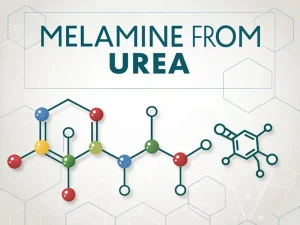
Tech Blog melamine from urea Melamine is well-known for its wide range of applications, but its raw material for production is surprisingly urea. For manufacturers,
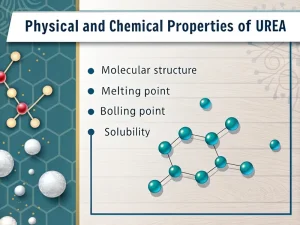
Tech Blog physical and chemical properties of urea Urea, with the chemical formula CO(NH2)2, is a simple organic compound that plays a central role in

JINGJIANG MELAMINE POWDER
© JINJIANG MELAMINE